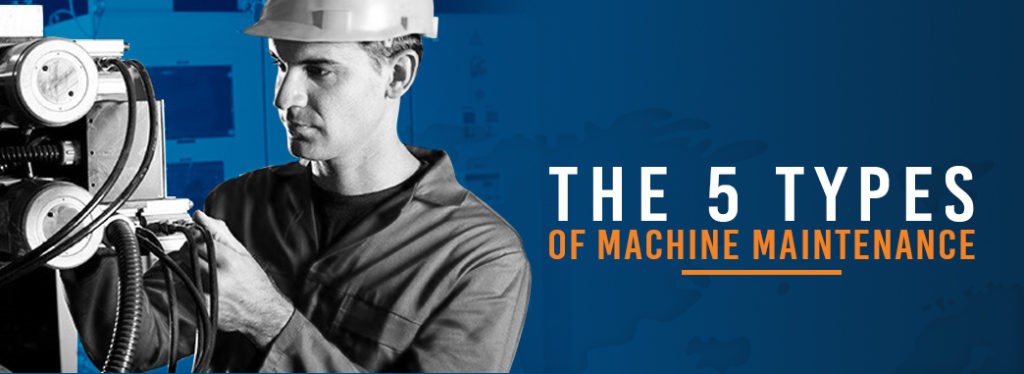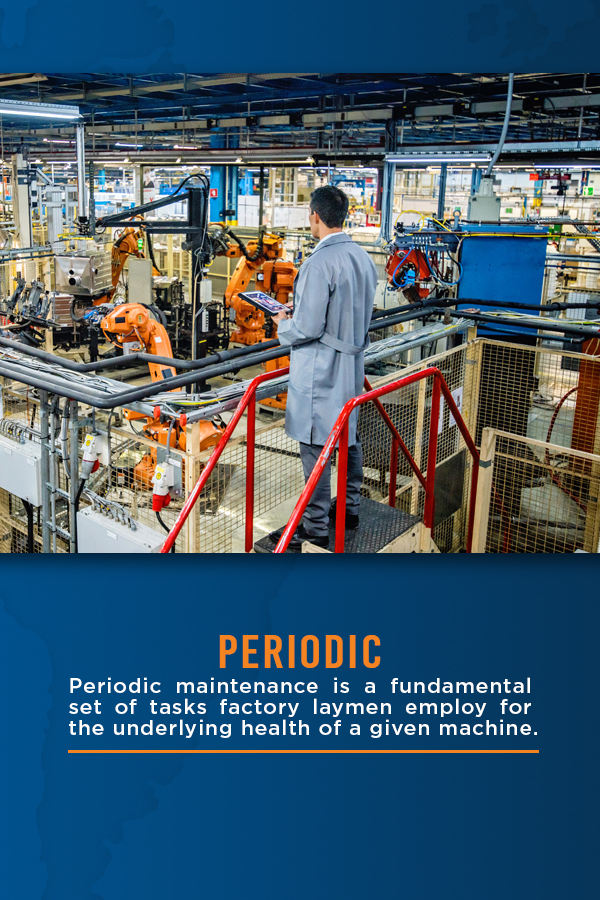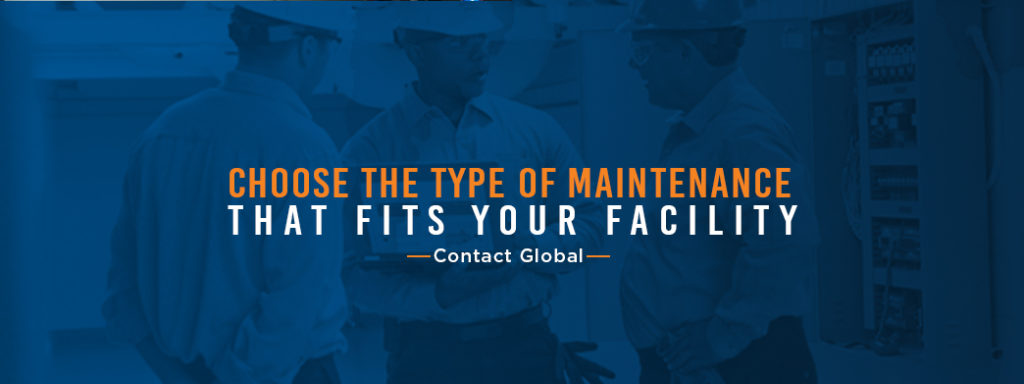The 5 Types of Machine Maintenance

In companies that use large arsenals of active machinery, it is crucial to establish maintenance protocols for all possible situations. If a machine displays warning signs of a looming malfunction, technicians must enact a set of measures to prevent downtime. If a device fails outright, technicians must be prepared to respond to that situation. Even if equipment appears to be in good condition, there are steps you should take to maintain that level of performance quality and avoid the other two possibilities.
Corrective
Corrective maintenance is a set of tasks designed to restore a piece of equipment to its original working condition. Through corrective maintenance, technicians seek to maintain the integrity of a machine or tool. As such, maintenance in this category generally follows the manufacturer’s specs and uses OEM parts. To ensure quality work, only company personnel who are familiar with the equipment in question should perform such maintenance. Industrial services like electronic and motor repair are often the results of corrective maintenance.
Pros and Cons
After the failure of a given piece of machinery, corrective maintenance usually involves a sequence of steps that typically lead to the following results.
- Accurate diagnoses: As soon as you discover a problem in a machine or peripheral, the first step is to make an analysis or run tests to diagnose the problem. This way, technicians can determine the best course of action going forward.
- Fresh parts: When a machine exhibits problems or fails to perform its functions properly, there will usually be a part that either needs service or complete replacement. In the latter scenario, technicians will immediately remove the faulty component upon discovery. Based on the make and model of the machine at hand, you will need to order a replacement part from the manufacturer. It is a general best practice to get an exact match, if possible, to maintain the integrity of the machine design.
- Restored equipment: Once you have received the replacement part, the next step is to install it, following the user’s manual that came with the machine in question. Only a skilled, experienced technician should perform this step.
- Revitalized performance: After adding the new part, the technician must perform tests to verify that the machine has accepted the installation. If the machine resumes its normal function, the maintenance steps have been a success. If not, it will be necessary to take further maintenance measures.
Many companies split the concept of corrective maintenance into the following two categories.
- Immediate corrective maintenance takes place immediately after the failure of a given piece of machinery. Companies often perform this type of maintenance for emergency purposes, such as when a vital machine fails during a high-cost, high-stakes operation. If, for example, a conveyor system halts in the middle of a production in which lost time equals lost money, factory personnel will perform emergency maintenance to kick-start the conveyor and resume operations.
- Deferred corrective maintenance is the measure taken for less urgent tasks, such as when a peripheral machine displays performance issues. Technicians opt for deferred maintenance with the general understanding that operations can continue unabated and that it’s best to handle any issues that might exist with a particular piece of equipment during off-time after a full review of the matter in question.
Depending on cost factors and reliability concerns, a company may not choose corrective maintenance as a viable option. Compared to preventive maintenance, whose goal is to circumvent problems in advance and keep costs moderate, instances that call for corrective maintenance may often involve unexpectedly high costs.
Preventive

Preventive maintenance is a set of tasks that prevent a machine from developing functional issues in the foreseeable future. With factory or office equipment, each new machine will incur wear and tear and lose functionality unless companies periodically take proactive action to increase its lifespan.
Through various types of preventive maintenance, companies can save money and avoid unexpected equipment failures and costly parts replacement. Companies can also use preventive maintenance to prevent the breakdown of servo motors and other components most in-house technicians cannot fix.
Pros and Cons
Examples of preventive maintenance include all the measures equipment owners perform to extend service life, yielding the following benefits.
- Regular fresh oil: Over time, oil can lose its viscosity and become acidic. When equipment owners allow oil in this state to fester inside an engine, corrosion and diminished lubrication are typically the prime consequences. Periodic oil changes are essential to prevent these problems from developing, as recommended in the user manual of a given piece of machinery.
- Timely greasing: Lubrication of the metal parts that move inside a machine prevents the development of corrosion, which forms when friction occurs between touching, grinding pieces of metal. Over time, lubrication itself can lose its viscosity and either melt or dry out, leaving the metal parts vulnerable to friction. Periodic application of grease to the metal joints and bearings in each piece of machinery will prevent this from happening.
- Fresh filters: To ensure internal cleanliness and ventilation, machines must have clear filters. Depending on the device at hand, filters could prevent air-bound dirt from getting sucked into the machine or keep the motor from overheating. Whether the filters serve one or both purposes, each filter needs regular cleaning or replacement to prevent dust buildup and possible overheating.
- Tight belts: Belts are necessary for various machines to regulate the movement of certain internal parts, such as fans. If a belt becomes dull or frayed, it could lose its elasticity and snap, sending the whole machine into chaos. To avoid that kind of situation, inspect belts regularly for signs of wear and replace them when appropriate.
Certain types of preventive maintenance can become a costly practice if equipment owners need multiple filter and belt replacements in the span of a given month. Some companies prefer to downplay proactive maintenance and reserve funds for the possibility of machine failure, if and when it occurs.
Predictive

Predictive maintenance is a set of inspections companies perform to determine the condition of active machinery. Based on the information gathered through this analysis, a company can then decide how often a given machine will need to undergo maintenance. These inspections can also help predict the likely remaining lifespan of a given machine, with or without preventive maintenance. Overall, the goal of predictive maintenance is to minimize the possibility of machine failure and downtime.
Pros and Cons
Various analyses fall under the category of predictive maintenance, such as vibration analysis and infrared thermography. When done in sequence, these steps will often yield the following results.
- Knowledge of physical indicators: Active machines vibrate at various levels of intensity. One measure companies take to determine the health of a machine is to submit it to vibration analysis. Based on the findings of a given investigation, company technicians can determine whether the machine in question vibrates at normal or troublesome levels.
- Detection of heating issues: Active machines emit varying levels of energy. The purpose of infrared thermography is to measure the amount of heat energy a machine emits at various points along its surfaces. Based on these findings, technicians can determine if the machine is emitting regular or irregular heat intensities.
- Oil health indicators: Even though oil is vital to the function of moving metals in most machines, oil can only be effective if it retains its purity and viscosity. After a specified amount of time, oil will lose its quality, though some oil supplies fail to live out their expected usefulness. The purpose of oil analysis is to examine the purity and viscosity of the supply in use. This information helps determine whether said supply can fulfill its purpose in a given machine. If not, technicians use this analysis to pinpoint which factors might be contributing to the rapid corruption of the oil in question.
- Visual evidence: The purpose of visual inspections is to attempt to identify problems or warning signs on a machine on sight.
Predictive maintenance can help technicians diagnose the health of a machine, though some would argue the methods involved are too scientific and that preventive maintenance is more efficient.
Zero Hours
Zero-hours maintenance is a series of steps to evaluate a machine periodically for signs of trouble. A machine might be subject to zero-hours maintenance once it has displayed mild performance issues. The purpose of zero-hours maintenance is to keep tabs on when equipment might ultimately need corrective maintenance. Zero hours takes place before a failure occurs, but when the symptoms are such that one could happen in the foreseeable future.
Ultimately, zero-hours maintenance allows technicians to identify looming problems and prepare for any associated expenses, but still use the equipment with caution in the meantime. Zero-hours maintenance helps technicians prevent scenarios where a machine abruptly and unexpectedly stops working, leaving operations in the balance.
Pros and Cons
With zero-hour maintenance — or overhaul, as it’s alternately called — a company will know what is in store with a particular piece of machinery, yet avoid anything too costly or disruptive for a lengthy period.
- Extended equipment life: Overhaul maintenance can extend the life of a machine. Whether the machine in question is large and complex or small and compact, your company could save untold sums of money with regular zero-hour maintenance.
- Reduced possibility of downtime: Well-maintained equipment is less likely to disrupt operations by failing unexpectedly. Overhauling equipment can save manufacturers from thousands of dollars in lost revenues that could otherwise occur in the event of a halted or ruined production.
- Less frequent replacement costs: Overhaul maintenance will usually prolong the usefulness of a machine, giving companies time to earmark funds for replacement equipment.
Companies with big budgets will often argue it is wasteful and time-consuming to keep older machines on borrowed time, and that corrective and preventive maintenance are a better use of resources.
Periodic
Periodic maintenance is a fundamental set of tasks factory laymen employ for the underlying health of a given machine. Unlike predictive and corrective maintenance, which are best to leave to highly skilled technicians, virtually anyone on a factory floor can perform periodic maintenance.
Pros and Cons

The steps involved in periodic maintenance range from the simplest tasks to the somewhat more involved measures of preventive maintenance, including the following.
- Regular data collection: On-floor personnel will make observations about the performance characteristics of a machine based on what they know about its functions. If the machine exhibits irregularities of any kind — stronger vibrations, louder engine noises, longer startup times — they will make a note of it and report it to management for review.
- Daily visual inspections: In any given company or factory setting, equipment operators will draw upon their knowledge of an arsenal of machinery to make observations about the health of each machine. If, for example, a worker notices moisture on the enclosure of a machine, they will write it down and submit it for further inspection by authorized technicians.
- Clean equipment: Non-specialists often receive authorization to perform basic cleaning tasks on designated arsenals of machinery. For example, a group of people assigned to operate printing machines will usually take on the responsibility of dusting the equipment regularly and changing the cartridges when necessary.
- Regular lubrication: After receiving appropriate training, rank-and-file company staff or factory workers may be able to apply lubrication on machine parts when necessary. If the task requires only a few simple drops in key areas, even laypeople can generally learn how to tell when a pre-existing oil application has gone stale and needs a refresher.
- Regular refastening: As machines vibrate continuously during endless months of use, screws can become loose on internal as well as external parts. If, for example, a machine enclosure starts to jitter to the vibration of the engine motor, the sound could easily be the result of loose enclosure screws.
Companies can often work more efficiently when they develop a plan to share maintenance tasks up and down the chain of command, though some would argue it’s better to have a qualified technician to handle every maintenance checklist item. Even then, it is an overall industry best practice for all company maintenance staff to undergo training and retraining for each new technological upgrade.
Choose the Type of Maintenance That Fits Your Facility

Machine maintenance is a vital practice for any company whose operations involve high-tech equipment. The costs that may otherwise result from neglect in this key area makes it crucial for maintenance staff to explore different types of preventive maintenance to determine which practices work best for a given set of machinery.
When the time does arise where a machine needs service or repair work, it is essential to have a reliable partner you can turn to for professional machine repairs. At Global Electronic Services, we repair everything from electronics and motors to hydraulics and pneumatics. Contact Global Electronic Services today for a quote on our equipment repair services.